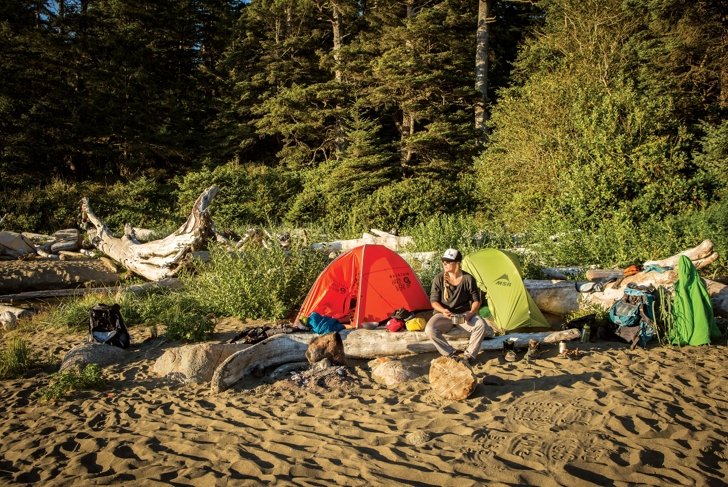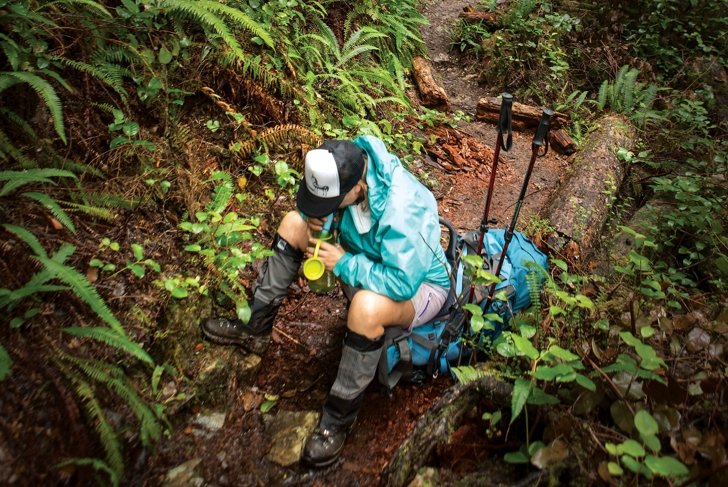
Whether you’re heading out into the wilderness on a multi-day hike or thinking about starting your hiking adventures with a day trip, you need to be prepared. Tap into expert advice to have a great outdoors experience.
Whether you’re a newbie or veteran to the backcountry, there’s always more to learn about staying safe as you navigate the great outdoors. We’ve gathered some wisdom from four hiking experts, some of their top tips for the perfect trip—from day hikes to multi-day wilderness adventures. Lay out your maps and start planning your summer!
Tasty trail tips
Veteran hiker of the West and the North Coast Trails Rhonda Viani can be found out in the backcountry year-round. As pastry chef of West Restaurant in Vancouver, food is important to Rhonda: “Just because meals need to be lightweight and cooked fast to avoid using too much valuable fuel, doesn’t mean flavour needs to be compromised.” Follow these top tips from Viani to keep things tasty on the trail.
Dehydrator
I recommend getting a dehydrator to dehydrate blueberries, whole rings of cored apple, and other fruits for snacks. I’ve turned a veggie-packed tomato sauce into a “leather” and reconstituted that; and I’ve made a bean, chickpea, and veggie chili which I dehydrated until it crumbled. Think Japanese: miso is great, soba noodles cook fast and are made of high-protein buckwheat, and seaweed is very good for you. Use angel hair pasta, which cooks quickly, and take dried parmesan to add flavour.
Snacks
Snacks are important, but you want to keep things interesting; I hiked the West Coast Trail with trail mix and couldn’t eat it for two years afterward! Now I keep fruit and nuts separate, so I’ll switch up dried cherries, cashews, licorice, chocolate, and so on. I make a high-energy cookie with dried fruit and nuts, [rather] energy bars.
Drinks
I always bring lots of tea bags; it’s amazing how much you’ll love a hot cup of tea at night. [Or] My essential is a flask of rum, which I mix with powdered hot apple cider tea mix for a hot toddy.
Bear cache
Use waterproof stuff sacks, which can mask food scent a little. On the West and North Coast Trails they provide bear caches for you, but essentially you need a rope, which you’ll tie to a rock or stick; throw that over a far-hanging branch and then pulley your stuff sack out of harm’s way. Make sure this is a good distance from your camp, and make sure you mark it on your GPS or bring flagging tape so you don’t lose it! You want to put everything—even toothpaste—that smells of food in the cache, and your garbage too.
Garbage
Take everything with you; I like reuseable zip-lock bags. Ideally you’ll have no food waste as you’ll have eaten everything—so no whole fruits (peels, pits, cores, etc.)!

Top food tips
- Make a meal plan and organize your meals out in separate bags for each day.
- Weigh portions.
- Always take an extra day’s supplies, just in case.
- Take electrolyte tablets at night to stay hydrated.
- Take good healthy portions; you’ll eat so much more when you’re hiking!
- Don’t bring high-energy food that you don’t like; it’ll only make you miserable.
- Add coconut powder, dried fruits, or chocolate to morning oatmeal to keep it interesting.
- Drink lots of water; nuts and dehydrated foods can be hard to digest.
- The week before a long hike, eat as much fresh fruit and veg as possible.
Staying safe on the trail
“When it comes to any kind of hike, my advice is to hope for the best, but plan for the worst,” says Lawrence White, executive director of the Alpine Club of Canada. “Pre-trip planning should never be underestimated: before you head out, you need to understand the terrain that you’re heading into, be up to date with the current weather patterns, and make sure that you haven’t bitten off more than you can chew when it comes to your mental and physical limitations.”
Follow White’s five rules to make sure you’re prepared for any kind of emergency.
Elevation
Prepare for mountain hiking by doing uphill day hikes, work on your cardio training, and even run stairs. People seriously underestimate their physical limitations when they come from sea level to the mountains.
Always have an exit plan
Know yourself and be honest: can you function in miserable weather, because that’s what it comes down to in the backcountry, so look at your route and find exit points. If you know you get miserable in adverse conditions, you’ll deal with it better if you know you have a way out.
Injuries
Any EMT [emergency] will say the more kit you can take the better, but practicalities like weight are key on a multi-day hike. Obviously, take any medication you need, and I always take a blister kit and a SAM Splint (foldable aluminum splint that wraps around sprains or breaks), which can help in an emergency. Get a pre-packaged kit that you can customize for your needs. Definitely pack a bandana; it’s one of those multi-purpose pieces of kit that’s good in the warm and cold, and even turns into a tourniquet if you need one.
Technology
The sky’s the limit with technology, but don’t forget the basics: have a map and compass and know how to use them. You may want to invest in a personal locator beacon, which uses GPS to send a signal when activated, and there are plenty of free apps you can use for maps on your phone too, but remember batteries die out.
Camp mindfully
Use the 30/30/30 rule: set your tent up in the middle of a triangle that’s 30 m (100 ft) from where you cook, 30 m from your water source, and 30 m from where you go to the toilet. That gives you adequate space for health and hygiene and also helps to avoid wildlife wandering into your camp. Make sure you contact Parks Canada, who do a great job with keeping the public informed about bear sightings and wildlife ranges, depending on the time of year.
Stay water wise
Staying hydrated is arguably the most important thing you need to do when you’re hiking, so always set up a water plan and research before you leave. Todd Mercer from Mountain Equipment Co-op (MEC) says, with the right equipment and proper planning, that’ll be a breeze.
“When you’re in high elevations or hiking in hot or humid conditions, you’ll need to drink a litre (48 oz) of water an hour. In cooler conditions you’ll need to drink around half of that; but it’s easy to become dehydrated, as you may not be aware that you need to drink.
Finding water
Streams may sometimes look dry, but hike up or down and look for pools of water percolating through rocks and sand. Look by stream beds for green grass, dig a hole there, and it will eventually fill. You can use a bandana to do a preliminary filter before you put it through your water pump. There are a variety of methods of treating water along the way.
Chlorine dioxide
You can buy chlorine dioxide in tablet form or in small bottles. Your water may taste of chlorine, but it will kill all the bacteria in the water. However, if the water is murky or marshy, it’ll taste murky or marshy—and of chlorine too. Consider carrying this for emergencies.
Pump systems
Still small, but certainly bulkier than chemicals, water filter pumps are great for longer trips where you’ll need to filter all your water to drink, cook with, and brush your teeth. They work by using two filters—carbon and ceramic— which remove impurities and any unpleasant flavours. They have a hose that you put into your water source; it takes around a minute to filter a litre (48 oz) of water.
UV water purifier
The SteriPEN is very small and looks like a large pen with a light at the end. This UV light is placed in the water to kill any bacteria. One of the drawbacks with this method is that you first need to clear water if it’s discoloured (with a coffee filter, for example) before it will work.
Things newbie hikers need to know about day hikes
Hike Canada, the National Trail of Canada, was launched in 1987. David Francis, Hike Canada’s board director for Ontario, has this advice for new hikers. Get more information from Hike Canada’s website: hikecanada.org.
- You’ll need a good pair of walking boots to support your ankle, and hiking socks, which are more padded. Most experienced hikers wear two pairs—a thin pair and a thicker pair—to help avoid chafing.
- Hiking poles can help on uneven ground.
- Always prepare for the worst-case scenario; if something goes wrong, you might be out overnight. Take a flashlight, food for the trail, and a small tarp so you can protect yourself.
- Even if you’re going hiking with a group, tell someone (not with your group) where you’re going, the route you plan to take, and what time you expect to be back. If you drive to a hiking spot, leave a note displayed on your car with a route plan and return time and ask that someone call emergency services if you’re not back as indicated.
- If you do get lost, stay where you are. Many people wander off, making it harder to find them.
- Weather can change rapidly, so dress in layers with clothes that zipper down the front so you can control your heat. Always pack a toque and wear a coat with a hood that will stay on and keep the wind out.
- Check the weather before you head out. The Canadian Weather Radar site will warn you of approaching storms. If the weather suddenly changes, be prepared to change your plans and head back.


